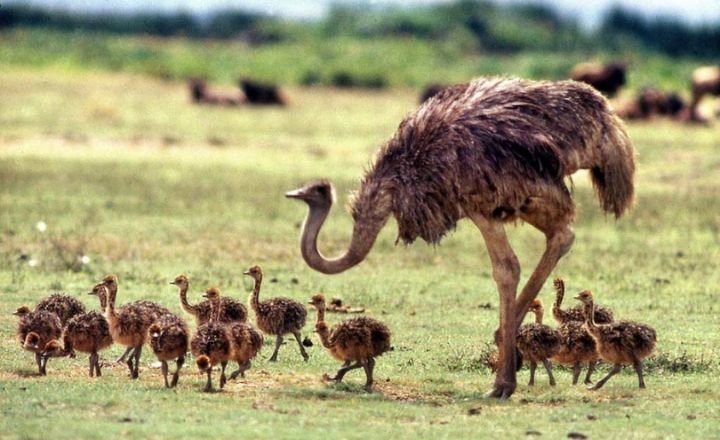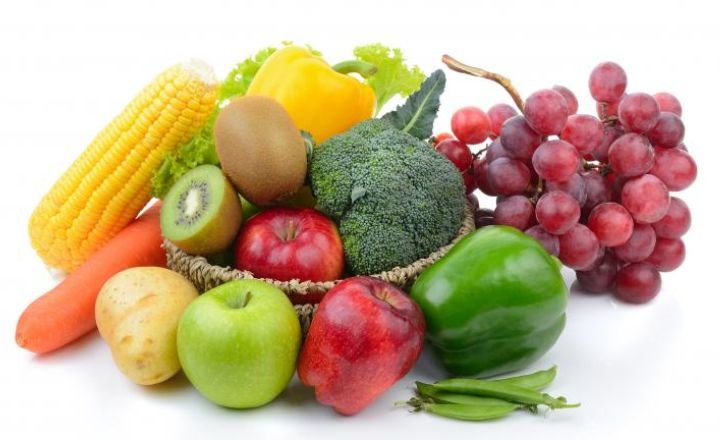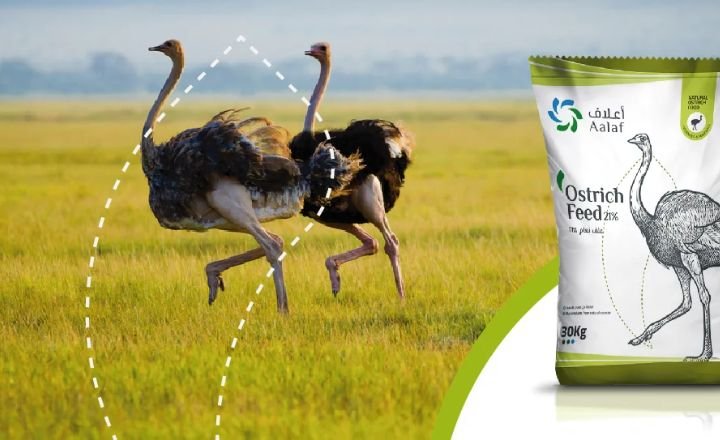A creature that can outrun most predators with its powerful legs, yet chooses to dine on a diet that might surprise you. The mighty ostrich, the largest and fastest bird on Earth, has garnered intrigue for centuries with its peculiar eating habits.
What do ostriches eat from feasting on stones to aid digestion to indulging in a buffet of vegetation, insects, and even small animals, these flightless giants have built a reputation as nature’s enigmatic gourmands.
While most birds flutter through the skies in search of grains to fuel their flight, the ostrich stands out as a colossal enigma, grounded yet graceful. Its inability to take flight and unconventional meal choices set it apart from its avian counterparts.
What Do Adult Ostriches Eat in General?
Adult ostriches are fascinating creatures when it comes to their dietary habits. Many may picture them peacefully grazing on grasslands, these birds have a surprisingly diverse palate.
The usual greens and plant matter, ostriches demonstrate their omnivorous nature by indulging in a range of delicacies. From insects like grasshoppers and locusts to small reptiles such as lizards and snakes, these giant birds show a willingness to explore different sources of nutrition.
The idea of an ostrich devouring a snake may initially seem peculiar, but it highlights the adaptability and resourcefulness of these birds in the wild.
Baby Ostriches
Unlike adult ostriches that can consume a variety of foods to thrive, baby ostriches have a more limited diet. In their early stages, these adorable creatures solely rely on plant matter like grasses, flowers, and leaves for sustenance.
This herbivorous diet provides them with essential nutrients and energy needed for their growth and development. As baby ostriches mature, their dietary preferences expand beyond plants to include insects, arthropods, and even small reptiles.

It’s fascinating to observe how the dietary habits of baby ostriches evolve over time to adapt to their changing nutritional needs. Dependent on vegetation for nourishment, they gradually incorporate protein-rich sources such as insects into their diet.
What Do Ostriches Eat in the Wild?
Baby ostriches, often referred to as chicks, have a fascinating journey ahead of them in this unpredictable world. They navigate their surroundings, they are exposed to a wide range of foods that contribute to their growth and development.
From tender grasses to juicy fruits and even small insects and arthropods, baby ostriches quickly learn to adapt their diet based on what is available in their environment.
Grasses
As fascinating as adult ostriches are in their diet, baby ostriches also play a crucial role in the ecosystem by consuming various types of grasses from an early age. These young birds have a diverse palate and are drawn to tender shoots of Indian grass and purple love grass, showcasing their adaptability even at a tender age.
Adult ostriches rely on a wide range of grass species for sustenance; baby ostriches’ preference for specific varieties reveals the intricacies of their dietary choices as they navigate the wild.
Fruits and vegetables
Figs and berries, the unsung heroes of the wild world, provide a bounty of nutrients for ostriches. These fruits are not only delicious but also pack a powerful nutritional punch, essential for the survival of these majestic birds.

Their supernaturally rich composition ensures that even in the harsh wilderness, ostriches can thrive on these humble offerings.
Insects, Arthropods, and Small Reptiles
In the vast savannas of Africa, ostriches are known to exhibit remarkable adaptability when it comes to their diet. They predominantly seek out plant matter for sustenance, they seamlessly shift their focus to hunting insects, arthropods, and small reptiles during the challenging winter and autumn months.
This dietary flexibility showcases the resourcefulness of these magnificent birds as they navigate through changing seasons.
Sand and pebbles
A world where your dinner required some pebbles and sand on the side to help digest it. Well, for ostriches and emus, this is a reality. These incredible flightless birds have evolved a unique way of processing their food by swallowing small stones to aid in grinding down the tough plant material they consume.
This process not only highlights the fascinating adaptations in nature but also showcases the ingenuity of these wild creatures in overcoming challenges.
What Do Domestic Ostrich Eat?
Domestic ostriches are truly pampered creatures, living a life of luxury that most wild ostriches could only dream of. Their diet is carefully curated to ensure they receive all the necessary nutrients and energy to thrive in captivity.
Keepers go above and beyond to provide a diverse array of ostrich-friendly foods, ranging from fresh grasses and plant roots to fruits, vegetables, and even chicken eggs.The interesting aspect of domestic ostrich care is the inclusion of non-traditional food items such as bone meal, charcoal, or pebbles.
These unconventional additions serve specific purposes in the ostrich’s diet, contributing essential minerals or aiding in digestion. The meticulous attention to detail in their feeding regimen highlights the dedication keepers have towards ensuring the well-being and health of these fascinating birds.
Grasses
Ostriches’ broad dietary preference for non-poisonous grasses highlights their adaptability in the wild. Their lack of selectivity when it comes to choosing grass types underscores their resilience as herbivores, capable of thriving on a diverse range of vegetation.
This unique trait sets them apart from many other grazing animals, as they can sustain themselves on various grass species without any discernible adverse effects.The fact that ostriches specifically seek out fresh and green grass further emphasises the importance of quality nutrition in their diet.

By consuming such high-quality vegetation, ostriches are able to maintain optimal health and energy levels required for their active lifestyle.
This natural inclination towards the freshest greens showcases the inherent instinctual wisdom ingrained within these majestic flightless birds, enabling them to make intelligent dietary choices in the wild ecosystem.
Plant Roots and Seeds
Ostriches, known for their impressive speed and large size, have a surprisingly delicate palate when it comes to food. The choice, these majestic birds would likely opt for plant roots and seeds as their preferred meal.
These nutritious options not only offer them essential nutrients but also cater to their natural instincts.
Fruits and Vegetables
Many bird keepers go to great lengths to ensure the health and well-being of their ostriches by incorporating a variety of fruits and vegetables into their diet.
For these overprotective keepers, offering treats like carrots, oranges, and brassicas adds not only nutritional value but also a sense of enrichment for their large feathered friends.
Ostriches, known for their unique dietary requirements of protein and calcium in significant quantities, benefit greatly from the inclusion of these nutrient-rich foods.
Bone Meal
The utilisation of bone meal and ratite pellets as a staple diet for domestic ostriches underscores a strategic approach to ensuring their nutritional needs are adequately met.
Serving as mere sustenance, these specialised food sources offer a comprehensive blend of essential vitamins and minerals crucial for the overall well-being of these majestic birds.
The dietary choice not only caters to their immediate nourishment requirements but also serves as an indirect means to bolster crop growth through the nutrient-rich components present in bone meal.
Ratite Pellets
Ostriches receive proper nutrition is essential for their health and well-being. Ratite pellets play a crucial role in providing these large flightless birds with the necessary vitamins and minerals they need to thrive.
As these birds primarily feed on grasses and plant matter, ratite pellets serve as a vital supplement, especially during times when their natural food sources may be scarce. By incorporating ratite pellets into their diet, keepers can help prevent deficiencies and ensure that emus and ostriches maintain optimal health.
These specially formulated pellets are designed to meet the specific nutritional requirements of emus and ostriches, catering to their unique dietary needs.
Rich in essential nutrients such as protein, vitamins, and minerals, ratite pellets serve as a convenient way to supplement the diets of these flightless birds.
Chicken Eggs
Wild ostriches, despite the fact that they possess the ability to eat eggs, often do not actively seek out this food source. This behaviour can be attributed to their natural environment providing them with an array of other food options to choose from.
Domestic ostriches have been conditioned to consume chicken eggs due to the nutritional benefits they offer. Specifically, these eggs are rich in essential minerals like phosphorus, calcium, and potassium which contribute to the overall health and well-being of the domestic ostrich population.
Insects and Arthropods
Vast expanse of the grasslands, ostriches stand tall and majestic, embodying a unique blend of herbivorous and carnivorous tendencies. Despite being primarily herbivores, these fascinating creatures possess the ability to adapt to their environment in remarkable ways.
Presented with the opportunity to indulge in insects or arthropods scurrying around their habitat, ostriches seamlessly incorporate these protein-rich snacks into their diet without hesitation.
Charcoal, Sand, or Pebbles
Pet ostriches are indeed a unique addition to any household, requiring a specialised diet that sets them apart from their wild counterparts. While domestic ostriches may share similar dietary preferences with their wild brethren, pet ostriches are often pampered with more indulgent options.
Instead of consuming traditional foods like grasses and insects, pet ostriches may be fed a diverse range of alternative ingredients tailored to their specific needs.
Ready-Made Ostrich Feed
A surprise that ostriches thrive on commercial feeds alone, without the need for additional fruits, vegetables, or grains. These flightless birds have evolved to efficiently extract essential nutrients from the formulated feed, making them well-suited for commercial farming practices.

While other livestock may benefit from a varied diet, ostriches seem content and healthy with their specialised feed.
Fruits and Vegetables
Pet ostriches, like most birds and animals, have a palate for fruits and vegetables that goes beyond mere sustenance. Their diet often includes a variety of produce such as juicy carrots, tangy oranges, and succulent berries. Providing these natural treats not only caters to their taste buds but also fulfils their nutritional needs in a wholesome manner.
Charcoal, Sand, or Pebbles
The use of charcoal, sand, or pebbles in the survival of pet ostriches showcases the adaptability and unique feeding habits of these flightless birds. While charcoal may seem like an unusual dietary supplement, it serves a specific purpose for ostriches by helping them grind their food effectively.
This demonstrates how ostrich caretakers have found innovative ways to meet the birds’ nutritional needs in captivity.
What Do Ostriches Living in the Zoo Eat?
The reality of zoos can be harsh and heartbreaking, especially when it comes to the welfare of the animals. While many visitors see these majestic creatures as mere entertainment, the truth is that every day is a struggle for survival for them.
The unfortunate ostriches, in particular, suffer from lack of proper care and nutrition, forced to live on a limited diet that doesn’t meet their natural needs.
Ready-made Ostrich Feed
Ostriches in zoos have a carefully curated diet that consists primarily of ratite pellets or other specially prepared feed. These pellet diets are formulated to meet all their nutritional needs and keep them healthy in captivity.
Zoo ostriches often enjoy treats like fruit and vegetables as a way to supplement their diet and provide enrichment. Carrots, berries, and oranges are among the favourite fruits that ostriches relish once or twice a week.
Grasses, Grains, Fruits, and Vegetables
Zookeepers have found creative ways to ensure that ostriches in captivity receive a well-rounded diet, including fruits and vegetables. Carrots and oranges are popular choices for these birds due to their nutritional benefits, providing essential nutrients like protein, iron, calcium, vitamin A, and K.
This not only satisfies the ostriches’ dietary preferences but also contributes to their overall health and well-being.
In the wild, ostriches eat primarily feed on a variety of grasses such as Indian grass and little bluestem. Replicating this diet in a zoo setting can present challenges in sourcing specific types of grasses. A result, offering fruits and vegetables serves as an effective alternative to ensure that captive ostriches receive a balanced nutritional intake similar to what they would consume in their natural habitat.
What Do Ostriches Eat to Entertain in the Circus?
The diet of circus ostriches may seem varied, but the reality is far from ideal for these majestic birds in captivity. Whole grains, fruits, and vegetables provide some nourishment, the addition of bone meal or ratite pellets raises ethical questions regarding their overall well-being.
Limited opportunities for natural foraging and hunting deprive them of essential physical and mental stimulation crucial to their survival instincts.
Grains
While it may seem unconventional for ostriches to consume grains instead of their natural diet of fresh grass, these circus birds have adapted to a diet rich in wheat, barley, oats, and sunflower seeds. Each grain provides a unique set of nutrients essential for their health and vitality.
Wheat offers a range of nutrients including protein and calcium, while barley contributes vital fibre, selenium, and manganese to their diet.Oats into the feeding regimen ensures that ostriches receive necessary amounts of copper, manganese, phosphorus, and protein. Sunflower seeds add magnesium, iron, protein, and selenium to complete the nutritional profile.
Caretakers can ensure that these majestic birds thrive in captivity while maintaining optimal health levels.
Fruits and Vegetables
Offering a variety of fruits and vegetables to circus birds like ostriches not only satisfies their taste buds but also provides essential nutrients for their health and well-being.
Carrots and beetroots, in particular, are packed with protein, iron, calcium, as well as vitamins A and K when consumed raw. This cost-effective method ensures that the birds receive a balanced diet without compromising on nutrition.
Carrots, beetroots, oranges, berries, and more into the circus birds’ diets, caretakers can enhance their overall health and vitality. The diverse range of fruits and vegetables allows for a holistic approach to nutrition, promoting strong immunity and vibrant plumage in these magnificent creatures.
This thoughtful selection of produce reflects a commitment to meeting the specific dietary needs of ostriches while enriching their daily lives with flavorful options.
Bone Meal or Ratite Pellet
Ratite pellets are like a superfood for emus and ostriches, packed with essential nutrients to support their growth and health. These specially formulated pellets ensure that the birds receive all the necessary vitamins and minerals in one convenient package.
With ratite pellets, circus birds can thrive even in environments where food options are limited, making them a popular choice among bird trainers.
Insects, Arthropods, and Small Reptiles
For ostriches, the presence of insects, arthropods, and reptiles is a double-edged sword. Fortunately, these small creatures provide a readily available source of food for the hungry ostriches.
Their incredible speed and agility, ostriches turn into fierce hunters when they spot these critters scurrying about. Their powerful legs propel them forward in a chase that showcases both raw instinct and survival skills.
Charcoal, Sand, or Pebbles
Ostriches, despite being classified as omnivores, have a truly unique way of digesting their food due to their lack of teeth. Their reliance on sand, pebbles, or charcoal to grind their food is essential for the breakdown of tough plant matter and other prey they consume.
This unconventional method not only aids in digestion but also highlights the resourcefulness and adaptability of these birds in obtaining necessary nutrients.
Final Thought
What Do Ostriches Eat are fascinating creatures with unique dietary habits. Their diet primarily consists of plants such as grass, fruits, and seeds, but they may also consume insects and small animals. Ostriches possess a specialised digestive system that allows them to efficiently process their food.
Understanding the nutritional needs of ostriches is crucial for their well-being in captivity and in the wild. Ostriches are primarily herbivores, consuming a diet rich in plants, seeds, and fruits.
FAQs
Do ostriches need a special diet in captivity?
Yes, ostriches do require a special diet in captivity to ensure their health and well-being. In the wild, ostriches primarily feed on plants, seeds, and insects.
Can ostriches overeat?
Yes, ostriches can overeat if given access to an unlimited food source. Ostriches have a voracious appetite and will continue eating as long as there is food available, which can lead to health issues such as obesity and digestive problems.
How often should an ostrich be fed?
Ostriches should be fed daily, with a diet that consists mainly of high-quality commercial ostrich feed. It is important to provide a balanced diet that meets their nutritional needs, including protein, vitamins, and minerals.
